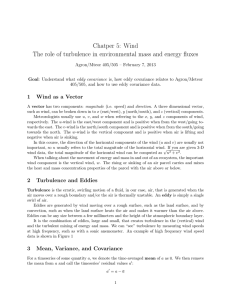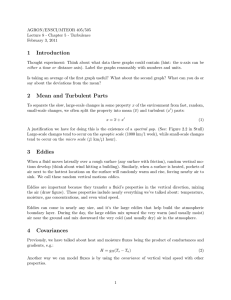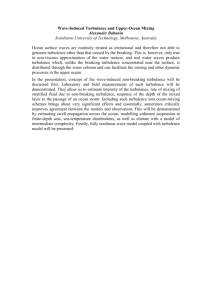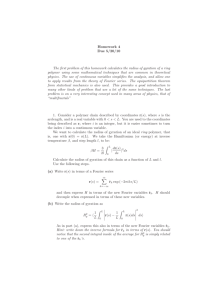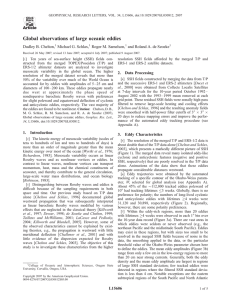Chapter 10, Part 1 Scales of Motion
advertisement
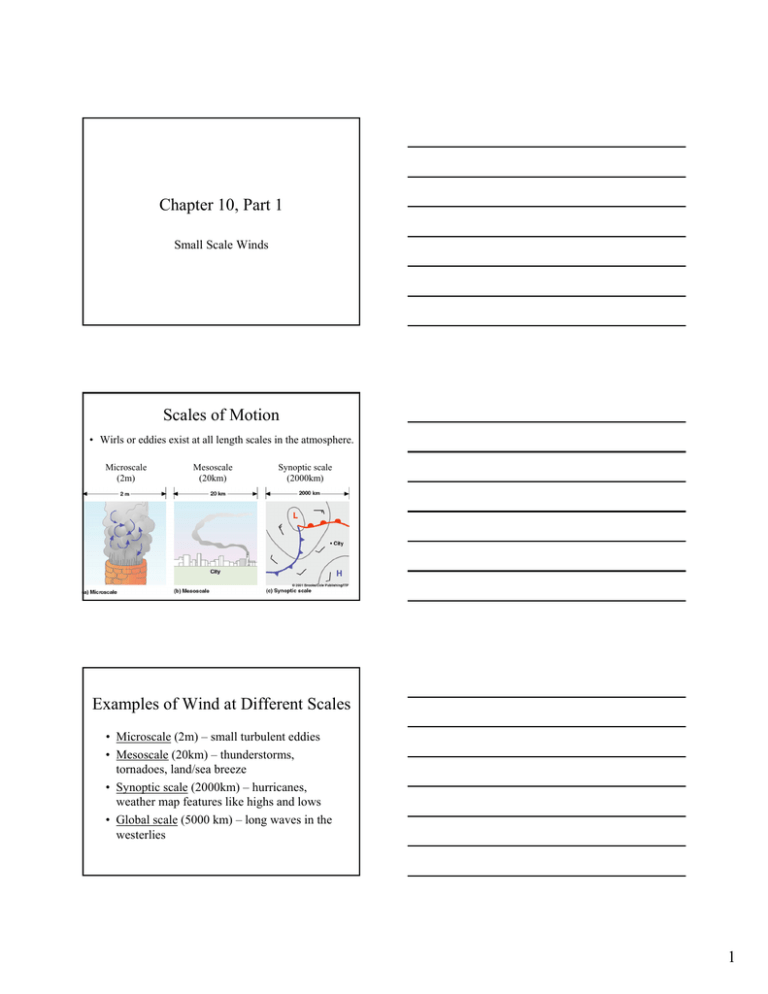
Chapter 10, Part 1 Small Scale Winds Scales of Motion • Wirls or eddies exist at all length scales in the atmosphere. Microscale (2m) Mesoscale (20km) Synoptic scale (2000km) Examples of Wind at Different Scales • Microscale (2m) – small turbulent eddies • Mesoscale (20km) – thunderstorms, tornadoes, land/sea breeze • Synoptic scale (2000km) – hurricanes, weather map features like highs and lows • Global scale (5000 km) – long waves in the westerlies 1 Speed Skating Jerry Lampen/Reuters • Why do speed skaters crouch down and put their hands behind them? Viscosity • The friction of fluid flow is called viscosity. • Molecular viscosity is due to the random motion of air molecules. • Eddy viscosity is due to turbulent whirling eddies. Development of Turbulent Flow • As long as the relative speed between the two air layers is small (small shear), there is no turbulence (laminar flow). • As the relative wind speed increases, the boundary deforms and then waves and eddies appear. • This leads to clear air turbulence. 2 Development of Turbulence • The size of the eddies increases as the wind speed increases and as the atmosphere becomes unstable by, for example, the solar heating of the ground. • Shown: mechanical turbulence and thermal turbulence. Planetary Boundary Layer • Because of friction the air near the ground moves slower than the air above. – Friction layer – Planetary boundary layer • With more vertical mixing of the air (e.g. unstable atmosphere) the difference in speed is smaller. Factors which Increase Turbulence • Surface heating – air rises producing strong thermal turbulence • High wind speeds – produces strong mechanical turbulence • Rough or hilly landscape – produces strong mechanical turbulence 3 Large and Small Eddies • Eddies form when air encounters an obstacle. • They occur on both large scales (mountains) and small scales (house). Eddy Formation • Eddies form on an objects leeward side. • Roll eddies or rotors can occur further downwind of the obstacle. Clear Air Turbulence • Wind layers moving at difference speeds (wind sheer) can lead to clear air turbulence, which is dangerous for flying. 4 Force of the Wind • Wind exerts force on objects. • This can move small particles like sand and dirt and for stronger winds large objects (e.g. in hurricances). Wind and Exposed Soil • Wind picks up tiny, loose particles (e.g. sand). • Removal of these particles, leaving only larger gravel and pebbles can lead to “desert pavement.” • Constant sand blasting of rocks causes a flattened and pitted windward surface. • Blowing sand comes to rest behind obstacles and eventually becomes a sand dune. • On a dune’s surface sand rolls and slides producing sand ripples. Wind and Snow Surfaces • Wind blowing over snow can produce snow dunes and snow ripples. • For a strong enough wind clumps of snow can be rolled along (snow rollers). 5 Snow Fences • Behind snow fences the wind speed is reduced allowing the snow to settle to the ground. • This keeps a blanket of snow on crops and keeps large drifts away from towns. Wind and Vegetation • Wind can bend and break branches. • Wind also causes plants to loose water more rapidly. Shelter Belts • Rows of trees decrease the surface wind speed and hence reduce erosion. 6 Wind and Waves • Waves forming by wind blowing over a water surface are called wind waves. • They depend on wind speed, the length of time the wind blows, and fetch (distance of deep water over which the wind blows). • Above: microscale winds help waves grow taller. Wind Direction • Wind direction by characterized by N, E, … or by an angle. • Other common terms are: – – – – Onshore wind Offshore wind Upslope wind Downslope wind. Prevailing Wind • The wind direction most often observed is called the prevailing wind. • A wind rose represents the percent of the time that wind blew in a given direction. 7 Measuring Wind Speed and Direction Wind Vane Cup Anemometer Aerovane Summary • Viscosity is the friction of air flow. • There are two sources: molecular and eddy. • Turbulence can be created by obstacles (mechanical) or air rising (thermal). • Near the surface the wind moves slower. • The wind strongly influences the surface of the earth (dunes, waves, …). 8
